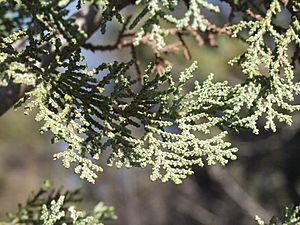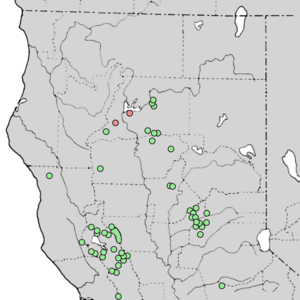MacNab cypress facts for kids
Quick facts for kids MacNab cypress |
|
|---|---|
 |
|
| Cupressus macnabiana foliage | |
| Conservation status | |
| Scientific classification | |
| Genus: |
Cupressus
|
| Species: |
macnabiana
|
 |
|
| Natural range | |
 |
|
| (Red circles indicate extinct populations.) | |
| Synonyms | |
|
|
The Cupressus macnabiana, also known as the MacNab cypress or Shasta cypress, is a type of cypress tree. You can find it growing in the western parts of North America. It's a unique plant that has adapted to its specific environment.
Where Does the MacNab Cypress Grow?
The MacNab cypress is a plant that is endemic to northern California. This means it naturally grows only in this area and nowhere else in the world. It is one of the most common native cypresses in California.
You can find this cypress in different types of natural areas. These include chaparral (a type of shrubland), oak woodlands, and conifer forests. It grows along the inner northern California Coast Ranges and the foothills of the northern Sierra Nevada. The MacNab cypress often grows in special kinds of soil called ultramafic soils.
What Does the MacNab Cypress Look Like?
The MacNab cypress is an evergreen plant. This means it keeps its green leaves all year round. It can be a shrub or a small tree. It usually grows between 3 to 12 meters (about 10 to 39 feet) tall. Sometimes, it can even reach 17 meters (about 56 feet).
Its branches spread out, making its top wider than it is tall. The leaves are a bright gray-green color. They grow in dense, flat sprays, which is different from most other California cypresses. The foliage also has a strong, spicy smell.
The leaves are very small, like scales, about 1 to 2 millimeters long. Each leaf has a sharp tip and a clear white spot in the middle. This spot is a resin gland. When the plant is very young, its first leaves look like needles and can be up to 10 millimeters (0.4 inches) long.
Reproduction: Cones and Seeds
The MacNab cypress produces two types of cones. The seed cones are where the seeds grow. They are shaped like an oval or a cube and are about 15 to 25 millimeters long and 13 to 20 millimeters wide. Each seed cone has six (sometimes four or eight) scales. Each scale has a noticeable bump, called an umbo.
These seed cones are very special because they are "serotinous." This means they do not open to release their seeds until the parent tree is killed by a wildfire. This is a clever way for the tree to survive. After a fire clears the ground, the seeds are released onto the bare soil. This helps new MacNab cypress trees grow in the newly cleared area.
The other type of cone is the pollen cone. These cones are smaller, about 3 to 4 millimeters long. They release their pollen in the fall season.



